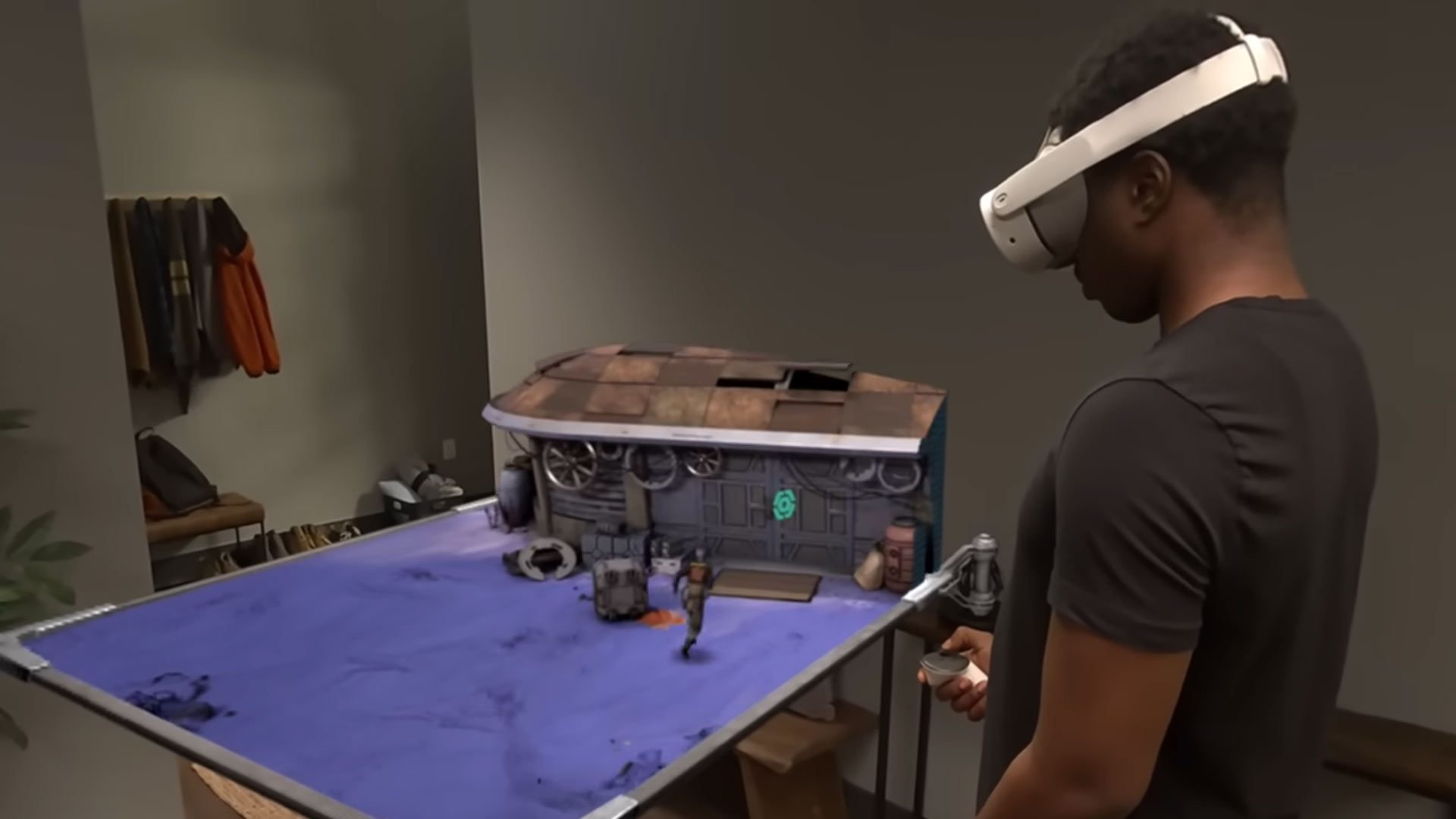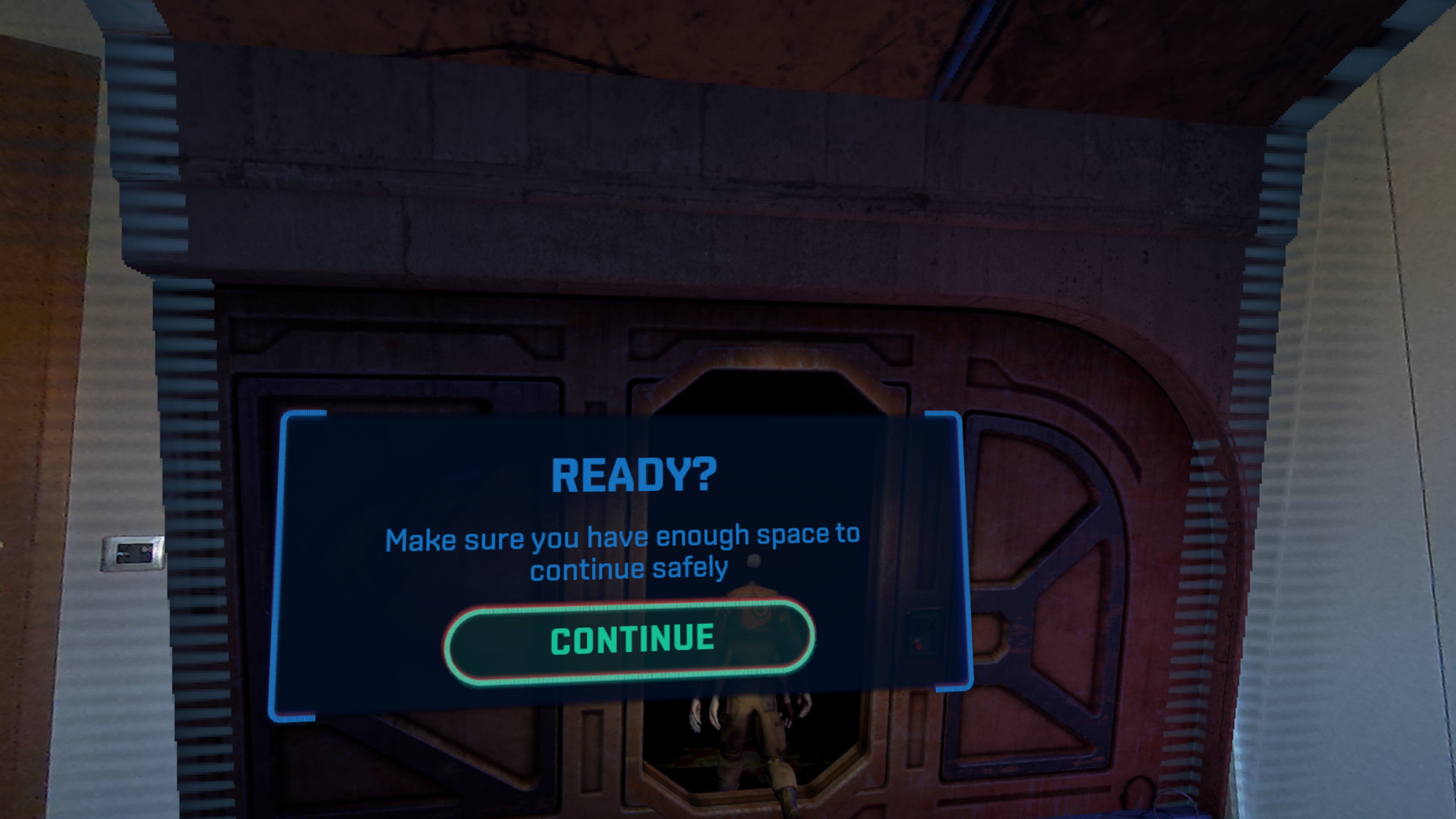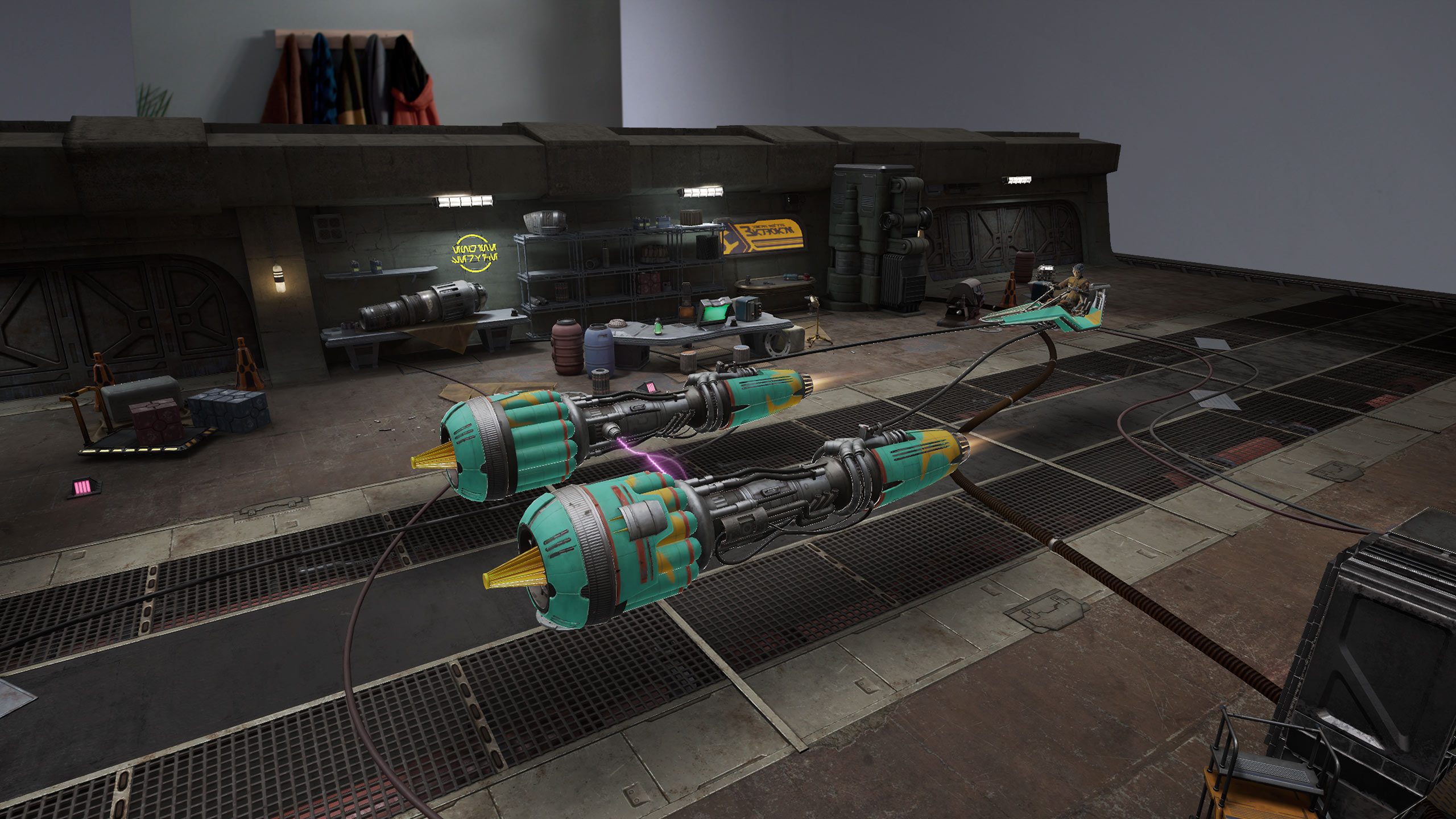Star Wars: Beyond Victory – A Mixed Reality Playset feels like a pretty clear directive to make a high quality MR game that showcases Quest 3’s passthrough capabilities. In that respect, it’s a partial success, as the MR/VR hybrid serves up some neat diorama-style racing action blended with a surprisingly heartfelt narrative, all the while packing in a healthy dose of the same high production value and visual wonder that made Vader Immortal such a success. Still, it was difficult to shirk the feeling halfway through that I’d much rather be playing this in VR.
Star Wars: Beyond Victory Details:
Developer: Industrial Light & Magic
Publisher: Disney Electronic Content
Available On: Quest 3 & 3S
Reviewed On: Quest 3
Release Date: October 7th, 2025
Price: $20
Gameplay
Star Wars: Beyond Victory offers up three single-player gameplay modes: a story-driven campaign, an arcade racing mode with four available tracks, and an extra little MR mode that lets you choose, resize and articulate game models and place them around your room.
While it does serve up a two-hour campaign, I can see why the “playset” naming was added here. Beyond Victory is more of an MR mini-game grafted to a much more engaging VR narrative, short as it may be.
It does this by periodically dropping you in and out of MR and VR modes when the game decides it’s time, like entering a building to fix your podracer (VR), actually podracing (MR), fetching a part for your friend (MR), or having one of those important narrative beats that really gives ILM a chance to flex its animation skills—which are absolutely second to none. Those narrative chunks happen both in MR and VR, with MR narratives playing out like multi-shot 3D cutscenes.
Putting you in the boots of the up-and-coming podracer Volo Bolus, you find yourself mixed up with the crafty and vicious podracing legend Sebulba, who has plans to help you get back on your feet after a nasty crash. Under Sebulba’s tutelage, you begin racing again—but at a price. No spoilers here, but let’s just say it involves crime.
Long after the credits rolled, I was still thinking about Volo’s struggles to balance his love for racing while trying to be true to his friends. It’s not about the grander rebellion against the Empire, or a Luke Skywalker analogue who is ‘The Chosen One’ with all of the requisite plot armor. You’re just a podracer who doesn’t want to get into trouble. But trouble finds you.
Across the campaign’s eight chapters, which feature some of the medium’s best animation, you’re treated to a handful of Mario Kart-style races. And the mixed reality 3D game board definitely taps into the LEGO portion of my brain, letting you resize it to fit your room. You can get it as small as a chess board, or as big as I got it here.
In the game’s four races (or race-adjacent getaway scenes), you’ll pick up health, boosters, and secondary ability recharges, which for Volo is a boosted jump to help you get ahead of nasty obstacles like jutting rocks and sticky orb-things. Each racer has their own loadout, which you can explore in the Arcade section of the game. There, you’ll find other racers and all four tracks. In campaign mode though, you’re locked into Volo’s racer, which isn’t upgradable.
Racing is a fun little experience, but it’s admittedly one without a ton of depth—more of a neat sideshow to the narrative. I don’t want to call it dinky, because it is a pretty fast-paced experience, but I think the ‘wow factor’ of it being on my living room floor is really doing the heavy lifting. I would be ‘wowing’ a lot more in VR, I can tell you that.
Okay, so this isn’t the VR podracing game of my dreams. And while racing micromachines can be mildly cool, the rest of the game’s MR implementation is a definite sore spot. More on that in the Immersion section below.

Moments in VR are typically filled with expressive narrative beats and moments to go hands-on with contraptions and objects that really sell the whole Star Wars universe vibe. But then there’s an MR overworld to navigate (seen above), which was something so painfully boring in comparison. Piloting my little two-inch Volo back and forth around the map is a questionable design choice—maybe one born from the necessity of justifying more mixed reality where it might be better replaced with first-person VR.
Thankfully, there is a good slice of fully immersive zones, which basically signal a return to actually fun interactions and more immersive narrative beats. In short, MR racing: alright. Anything else MR: no thanks.
In VR, you’ll be treated to interesting one-off tasks to repair your ship, which include a bevy of tools and contraptions, like welders, automatic screw drivers, and ship parts galore—all of which are cleverly given to you by your second set of arms. Need a wrench? Your hand just presents it to you at the height of a holster.
In the end, I think ILM did an okay job of integrating MR into Beyond Victory given the current hardware, which isn’t really saying much.
It’s still early days, and Quest 3 can’t really understand your room, which means developers don’t have the ability to create systems that can dynamically use it to good effect—one such exception being Starship Home (2024)—making the sort of 3D gameboards you see in Beyond Victory a sort of low-hanging fruit. It is admittedly just a playset, after all, and I think setting player expectations was an unfortunate necessity.
Immersion
For all its MR dull spots, Star Wars: Beyond Victory tries its level best to make up for it with a series of expertly realized VR set pieces and character design, the latter of which shines when it comes to motion capture, animation, voice acting—the lot.
In VR, it’s just as impressive as Vader Immortal, which is one of my favorites to show off in the Venn diagram of my Star Wars nerd-friends who don’t own a VR headset.
That said, by relying on MR, the studio essentially unlocked the ability to include a ton of cutscenes, which do some of the heavy narrative lifting—making it feel like I was watching a 3D TV in my living room—okay, maybe more of a volumetric TV.
From a game mechanics perspective, I’m not against having any of that when it actually makes sense within the context of the world. As it is, Beyond Victory shifts you between MR and VR not because you need to pilot a podracer like a drone, or move a two-inch droid around the map because your real body is partially imprisoned in carbonite, or for any other reason that might suspend disbelief for the full two hours.

You’re just in your living room one moment, and unceremoniously in a podracer garage with Sebulba the next. Simple narrative explanations, and maybe a bit of magic to dress my room up in MR to make it feel more like a galaxy far far away (and less like where I’m writing this review), could have bridged that inexplicable gap from being so jarring.
Okay, I do have one gripe about the game’s VR bit. Oftentimes there are invisible walls in larger areas, which force you to stay within a set zone, usually for narrative reasons. Since Beyond Victory isn’t fundamentally a large format VR game though, I found it mostly forgivable, although still less immersive than it might have been.
Comfort
For all my gripes, the MR mode is very comfortable, allowing you to reposition and resize the board to fit your playing style, whether that be on the floor or in your lap. Podracing is frenetic, so your physical room anchoring you in place should be comfortable for most everyone.
As for the VR, there aren’t any wild rides or moments of forced locomotion outside of the optional head shake, which you can turn off in the settings. Locomotion options include your standard set of comfort modes, including teleport and smooth movement, smooth and variable snap-turning, and also standing and seated modes.
‘Star Wars: Beyond Victory – A Mixed Reality Playset’ Comfort Settings – October 7th, 2025 |
|
Turning |
|
| Artificial turning | |
| Snap-turn | ✔ |
| Quick-turn | ✖ |
| Smooth-turn | ✔ |
Movement |
|
| Artificial movement | |
| Teleport-move | ✔ |
| Dash-move | ✔ |
| Smooth-move | ✔ |
| Blinders | ✖ |
| Head-based | ✔ |
| Controller-based | ✔ |
| Swappable movement hand | ✖ |
Posture |
|
| Standing mode | ✔ |
| Seated mode | ✔ |
| Artificial crouch | ✔ |
| Real crouch | ✖ |
Accessibility |
|
| Subtitles | |
| Languages |
English, French, German, Japanese, Korean, Spanish (Mexico), Spanish (Spain)
|
| Dialogue audio | |
| Languages | English |
| Adjustable difficulty | ✖ |
| Two hands required | ✔ |
| Real crouch required | ✖ |
| Hearing required |
✖ (via accessibility option)
|
| Adjustable player height | ✖ |
,
